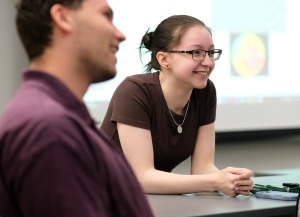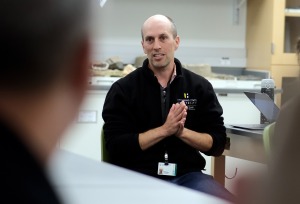Most students are sitting back, relaxing and soaking up the rest of summer vacation.
But that hasn’t been the summer scene for Fitchburg State University students Sara Beaulac and Ethan Chaco.
Beaulac and Chaco have dedicated a good portion of their summer to working with Dr. Reid Parsons in a NASA-funded research project related to ice ages on Mars and some enigmatic features found on the Martian surface.
“We’re interested in trying to understand what these features tell us about when and for how long Mars went into an ice age,” said Parsons, an associate professor in the Environmental, Geographic & Public Health Sciences Department.
Beaulac and Chaco each presented their research projects to a small group of faculty recently in a classroom at the Antonucci Science Complex.
“They’ve really elevated the level of undergraduate research,” Parsons said. “I didn’t necessarily think undergraduates would be capable of doing this level of research, and I was a little unsure about that when I applied for the grant initially. But working with students, even previous to Ethan and Sara, I realized that our students can actually do a lot. We’re ahead of schedule in terms of what we were hoping to accomplish for the grant, so it opened my eyes to how productive our undergraduates could be when it comes to research. I’ve been pleasantly surprised with the level of work they are capable of.”
This informal presentation will serve as a learning tool for Beaulac and Chaco, who will officially present their work in December at the American Geophysical Union (AGU) Conference in New Orleans.
“I know what I can do better, and know what I can fix overall,” said Beaulac, a junior from Fitchburg who is majoring in environmental science with a minor in geographic information systems. “I have never been to a conference for anything. I haven’t really traveled at all, so this will be a whole new experience. It’s a huge conference of 30,000 people. It’s amazing because I’ve never done anything like this.”
Chaco, who resides in Townsend, said that presenting in front of a small audience was a great way to get all of their ideas together and help sharpen their presenting skills.
“This is a great practice to kind of get that down and practice explaining it to really intelligent people,” said Chaco, a transfer student who is majoring in earth science with a minor in geographic science and technology.
Parsons says his students “dove in very eagerly” to the project, first immersing themselves into a lot of background research.
“Sara did a series of experiments and that was a lot of fun and kind of messy,” Parsons said. “She showed a lot of resolve in trying to problem solve on the fly and how to make the experiment work better. Ethan was doing a lot of work on the computer, doing some mapping of these glacial features on Mars and comparing them to outputs from computer simulations. He was doing this pretty complicated computer work.”
Beaulac conducted six experiments along the way, using slime made from a Borax solution and glue.
“It was trial and error the first few times, and then we figured out what worked and what didn’t,” she said. “The whole thing was just new to me. It was like this is how science happens. It was trial and error, over and over again.”
Chaco says that he had no prior knowledge about Mars before this research project, and there was even a period of time that he didn’t know what he wanted to do in college.
But he now has a passion and a purpose to learn.
“I like hiking and being outside, so I thought that I might as well study the Earth,” Chaco said. “I started studying the Earth and it never crossed my mind that I’d be researching the surface of Mars.”
This research journey all started with an email from Parsons to Chaco, asking him to be a part of the project.
“I thought it sounded amazing,” Chaco said. “Never would it have crossed my mind that I’d be a part of something like this. It’s been an amazing experience. A door opened and I went through it. Now, I think this is something I want to continue on with. I really enjoyed this research and this process of research of what I did. I want to continue on in my education in this path.
“The amount I’ve learned in the last two months is mind blowing,” Chaco continued. “I’ve fallen in love with learning.”
He loves Fitchburg State, too, after enrolling in the spring of 2022 after brief stints at two different institutions.
“I took my first class with Dr. Parsons, an earth science class, and I fell in love with it,” Chaco said. “I love Dr. Parsons as a teacher. As I continued on, I realized that all the professors in this department were amazing. I was able to get to know them and they were able to get to know me as a student, and that’s different from the other experiences that I’ve had at the other schools where the professors didn’t seem to necessarily care as much. Here, you get a lot of classes with the same professors and they really get to understand you and they care about you and your success. I really appreciated that, and that’s something I really like about Fitchburg State.
“I tell people that I love this department and I love the professors here. This has been a great experience. Up until I started here my priorities weren’t education. I would do what I needed to do to get by, but now I have that excitement that I want to do this and I want to see how much I can learn. I want to push myself.”


